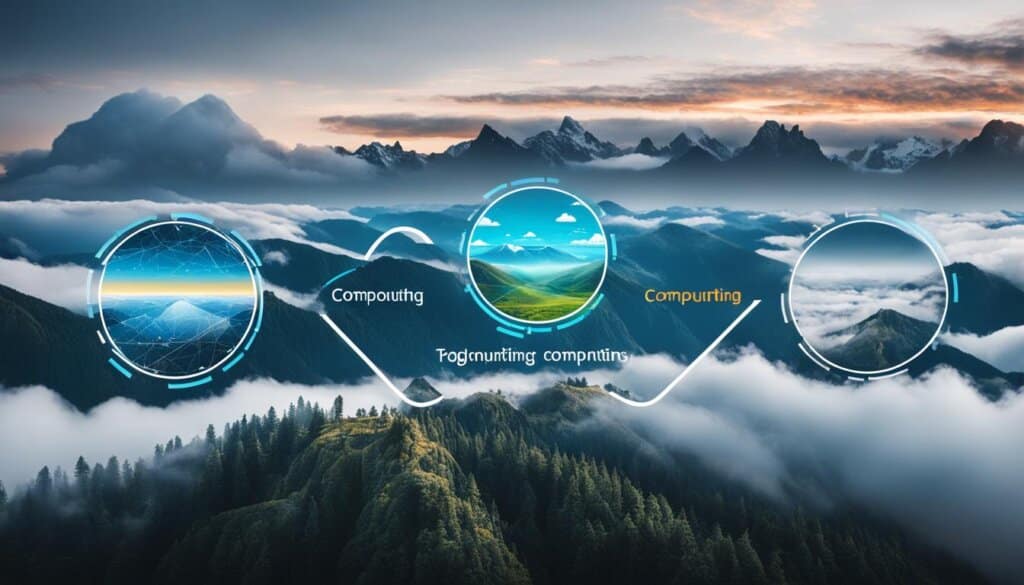Table of Contents
Edge computing is a distributed information technology architecture that processes client data at the periphery of the network, closer to the data source. It has emerged as a solution to the challenges posed by the increasing volume of data generated by sensors and IoT devices.
Traditional computing paradigms built on centralized data centres and the internet are not well-suited for handling large amounts of real-world data due to bandwidth limitations, latency issues, and network disruptions. Edge computing moves storage and compute resources closer to the source of data, enabling real-time processing and analysis.
This reshapes IT and business computing, offering benefits such as improved data processing speed, reduced latency, and the ability to handle remote or inhospitable environments.
How Does Edge Computing Work?
Edge computing functions by moving computing resources closer to the location where data is generated. In traditional enterprise computing, data is produced at client endpoints and transmitted over a wide area network (WAN) to a central data centre for processing and analysis. However, the rising number of connected devices and the sheer volume of data being generated is overwhelming conventional data centre infrastructures. To tackle this challenge, edge computing brings storage and computing resources to the edge of the network, where data is generated.
Edge devices, such as IoT gateways, industrial controllers, and smart displays, possess sufficient processing power and computing resources to collect, process, and analyse data in near real-time. This eliminates the need to transmit raw data to a central data centre and enables quicker decision-making and more efficient operations. By deploying edge computing, companies can significantly reduce the latency and network congestion associated with transmitting vast amounts of data to a central location.
As a visual representation, the following table illustrates the key differences between traditional enterprise computing and edge computing:
| Traditional Enterprise Computing | Edge Computing |
|---|---|
| Data is transmitted across a wide area network (WAN) to a central data centre. | Data is processed and analysed at the location where it is generated. |
| Relies on a central data centre for storage and computing resources. | Brings storage and computing resources closer to the data source. |
| May result in latency issues due to data transmission and network congestion. | Enables near real-time processing and analysis, reducing latency. |
| Remote locations rely on the central data centre for data processing. | Allows for local data processing in remote locations. |
| Requires high-bandwidth data transmission across the WAN. | Minimizes data transmission by processing data at the edge. |
Edge Computing vs. Cloud Computing vs. Fog Computing
Edge computing, cloud computing, and fog computing are all related concepts that revolve around the idea of distributed computing and the physical deployment of compute and storage resources in relation to data. Each approach has its own characteristics and addresses different requirements based on resource location and usage.
Edge computing focuses on deploying computing and storage resources at the location where data is produced, which is typically at the network edge. This approach allows for real-time processing and analysis of data as it is generated, enabling faster decision-making and immediate actions. Edge computing is well-suited for use cases that require low latency and rapid response times, such as autonomous vehicles or industrial control systems.
Cloud computing, on the other hand, relies on centralized data centers that offer highly scalable compute and storage resources. It provides a centralized platform for processing and analyzing data from various sources. Cloud computing is often used for complex analytics, big data processing, and running resource-intensive applications. It offers the advantage of scalability and flexibility, allowing organizations to easily scale up or down based on demand.
Fog computing takes a step back and places compute and storage resources “within” the data, rather than “at” the data. It focuses on the physical and logical distribution of resources across a wide area network, enabling efficient processing and analysis at the network edge. Fog computing is particularly useful for handling large-scale deployments across expansive physical areas, such as smart cities or industrial IoT applications.
Here is a comparison table summarizing the key characteristics of edge computing, cloud computing, and fog computing:
| Aspect | Edge Computing | Cloud Computing | Fog Computing |
|---|---|---|---|
| Resource Location | At the network edge | Centralized data centers | Distributed across the network |
| Usage | Real-time processing of data at the source | Scalable compute and storage for complex analytics | Efficient processing across wide area networks |
| Main Benefits | Low latency, rapid response times | Scalability, flexibility | Large-scale deployments, efficient network utilization |
| Use Cases | Autonomous vehicles, industrial control systems | Big data analytics, resource-intensive applications | Smart cities, industrial IoT |

By understanding the differences between edge computing, cloud computing, and fog computing, organizations can choose the most suitable approach for their specific use cases and resource requirements. It’s important to consider factors such as data location, processing speed, scalability, and network efficiency to ensure optimal performance and cost-effectiveness.
Benefits of Edge Computing
Edge computing offers several benefits for businesses and users. It allows for rapid response times because data processing happens closer to the data source, eliminating the lag caused by transmitting data to a central data centre. It is especially beneficial for use cases that require real-time or extremely rapid results, such as self-driving cars or telesurgery.
Edge computing also handles high data volumes more efficiently, reducing the cost of transmission and taking advantage of the physical limitations of network capacity. By processing data at the edge, companies can avoid the need to transmit large amounts of data over long distances, resulting in faster and more cost-effective operations.
In addition to rapid response and efficient data handling, edge computing addresses privacy concerns. Sensitive data can be processed locally at the edge, ensuring that it remains within the boundaries of the network and not sent to the cloud, reducing potential privacy risks. This is especially crucial in industries that handle highly confidential or regulated data.
Furthermore, edge computing brings significant advantages to remote areas with limited connectivity. Traditional computing models heavily rely on a stable and fast internet connection, which might not be available in remote locations. By deploying edge computing resources in these areas, businesses can ensure uninterrupted operations and leverage the benefits of localized data processing.
Cost sensitivity is another area where edge computing shines. By deploying only the necessary services and functionality at the edge, companies can optimize their costs and allocate resources where they are most needed. This allows for efficient resource allocation and cost savings, making edge computing an attractive option for budget-conscious organizations.
Another critical aspect of edge computing is its ability to enable autonomous operations. Even when connectivity to the cloud is lost, processing can continue at the edge. This ensures that critical operations can proceed without interruption, providing a level of autonomy and resilience to businesses that rely on real-time data processing.
Finally, edge computing significantly improves user experiences. By reducing latency and enabling rapid response times, edge computing ensures that data-driven applications, services, and devices respond quickly to user inputs. This translates into seamless and immersive user experiences, enhancing customer satisfaction and loyalty.
| Benefits of Edge Computing |
|---|
| Rapid response times |
| Efficient handling of high data volumes |
| Privacy preservation |
| Connectivity in remote areas |
| Cost optimization |
| Autonomous operations |
| Improved user experiences |
Edge Computing Use Cases
Edge computing has revolutionized various industries by enabling innovative applications and enhanced capabilities. Let’s explore some examples of how edge computing is being utilized in different sectors:
Retail
One prominent use case of edge computing in the retail sector is frictionless store checkout. By leveraging edge computing, retailers can process data collected by on-site cameras locally. This enables accurate and efficient customer account charging without the need for customers to wait in line. The real-time analysis of data at the edge ensures a seamless shopping experience for customers, optimizing convenience and reducing transaction time.
Healthcare
Edge computing plays a crucial role in advancing healthcare through applications like robot-assisted surgery. By processing data at the edge, edge computing enables smaller incisions and improved control for surgeons. This technology ensures precise and efficient surgical procedures, enhancing patient outcomes. Additionally, edge computing enables the secure and efficient processing of sensitive healthcare data, ensuring privacy and compliance with regulations.
Intelligent Machines
Edge computing is instrumental in deploying intelligent machines across industries. In areas such as smart signage and assembly-line quality assurance, edge computing enables real-time productivity and optimization. By leveraging edge computing capabilities, intelligent machines can process data close to the point of generation, improving efficiency, reducing latency, and enabling faster decision-making.
Close to Consumption
Edge computing optimizes digital production and consumption processes, bringing data processing capabilities closer to the point of consumption. This approach offers a seamless and immersive user experience in applications such as extended reality (XR), including virtual reality (VR) and augmented reality (AR). By reducing latency and enabling real-time interactions, edge computing enhances the quality and responsiveness of XR applications, resulting in a more engaging and immersive experience for users.
Secure and Private Wearable Health Devices
Edge computing ensures privacy and security in scenarios involving wearable health devices. By processing data locally on the edge devices, sensitive health data can remain protected and avoid transmission to external servers. This enhances data privacy and security, empowering users to take advantage of wearable health devices without compromising their personal information.
Always-On and Untethered Operations
Edge computing enables always-on and untethered operations, making it ideal for mission-critical applications and remote environments. By leveraging edge computing resources, organizations can ensure continuous operations even in the absence of reliable cloud connectivity. This is essential for scenarios that require uninterrupted functioning, such as remote industrial sites or critical infrastructure.
With its diverse range of applications, edge computing continues to transform industries, enabling optimized performance, enhanced user experiences, and secure data processing.
Edge Computing and IoT
Edge computing plays a crucial role in the Internet of Things (IoT) ecosystem. While IoT devices are not necessarily edge devices, they are often part of an organization’s edge strategy. Edge computing brings more compute power to the edges of an IoT-enabled network, reducing the latency of communication between IoT devices and central IT networks.
By processing data locally, edge computing enables rapid decision-making and improves operational efficiency. It complements the large amount of data generated by connected IoT devices and facilitates the deployment of analytics algorithms and machine learning models at the edge.
This results in faster response times, better predictions, and more relevant information for optimized IoT operations. With edge computing, businesses can unlock the full potential of their IoT devices, harnessing the power of data processing and rapid decision-making.
Benefits of Edge Computing in IoT
- Reduced latency: Edge computing reduces the time it takes for IoT devices to transmit data to central IT networks, resulting in quicker response times and real-time insights.
- Improved efficiency: By processing data locally, edge computing offloads the burden on central IT networks, optimizing bandwidth usage and improving overall system efficiency.
- Enhanced security: Edge computing allows sensitive data to be processed and analyzed locally, reducing the risk of data breaches during transmission to central servers.
- Scalability: Edge computing enables organizations to scale their IoT deployments easily, as compute power can be added at the edge without the need for significant infrastructure upgrades.
Edge computing brings the power of processing and decision-making closer to the source of data in IoT networks, enabling businesses to harness real-time insights and optimize operational efficiency.
Edge Computing in Telco and 5G Networks
Telco service providers are increasingly adopting edge computing as they modernise their networks and seek new revenue sources. By moving workloads and services from centralised data centres to the network edge, service providers can optimise resource usage and improve the customer experience. Edge computing is particularly relevant for telcos in the context of 5G networks, which require low latency and expanded coverage.
Edge computing helps meet the performance requirements of 5G networks and supports other edge use cases. Telcos are investing in building the right ecosystem and coordinating with stakeholders and technology partners to provide edge computing solutions. Open-source platforms ensure interoperability and enable new edge computing use cases. Red Hat, for example, is investing in upstream open-source communities like Kubernetes and OpenStack to support edge computing initiatives in telco networks.
With edge computing, telcos can achieve network modernisation, resource optimisation, and deliver a superior customer experience. By decentralising their infrastructure, telcos can reduce latency, improve data processing speed, and handle high data volumes. These advantages are critical in delivering on the promise of 5G networks, which require ultra-low latency and efficient management of vast amounts of data. Edge computing empowers telcos to unlock the full potential of 5G and provide innovative services to their customers, paving the way for a more connected and digital future.
FAQ
What is edge computing?
Edge computing is a distributed information technology architecture that processes client data at the periphery of the network, closer to the data source. It has emerged as a solution to the challenges posed by the increasing volume of data generated by sensors and IoT devices.
How does edge computing work?
Edge computing works by moving computing resources closer to the location where data is generated. Edge devices, such as IoT gateways, industrial controllers, and smart displays, have enough processing power and computing resources to collect, process, and analyze data in near real-time.
What is the difference between edge computing, cloud computing, and fog computing?
Edge computing involves deploying computing and storage resources at the location where data is produced, at the network edge. Cloud computing relies on centralized data centers, while fog computing places compute and storage resources “within” the data. These concepts have different resource locations and are used for different purposes.
What are the benefits of edge computing?
Edge computing offers several benefits, including improved data processing speed, reduced latency, and the ability to handle remote or inhospitable environments. It allows for rapid response times, handles high data volumes efficiently, addresses privacy concerns, enables cost optimization, and ensures autonomous operations.
What are some use cases of edge computing?
Edge computing has diverse use cases in various industries, such as frictionless store checkout in the retail sector, robot-assisted surgery in healthcare, and real-time productivity in areas like smart signage and assembly-line quality assurance.
How does edge computing relate to the Internet of Things (IoT)?
Edge computing plays a crucial role in the IoT ecosystem by bringing more compute power to the edges of an IoT-enabled network. It reduces communication latency between IoT devices and central IT networks, enables local data processing, and facilitates the deployment of analytics algorithms and machine learning models at the edge.
How is edge computing relevant to telco and 5G networks?
Telco service providers are increasingly adopting edge computing to optimize resource usage and improve the customer experience. Edge computing is particularly relevant for telcos in the context of 5G networks, as it helps meet the performance requirements of such networks and supports other edge use cases.













